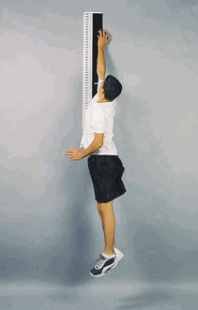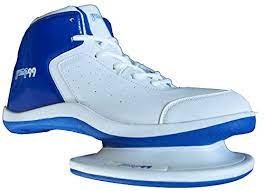HOW TO INCREASE VERTICAL JUMP – 7 PROVEN WAYS
Not sure how to increase vertical jump ability? Here are 7 things you can do to add inches to you vertical.
The ability to jump up, hang in the air and dunk the basketball used to be an art only a few blessed individuals like Dr. J, Michael Jordan and a few others were given.
But thanks to science and better strength training & conditioning programs we now have access to different methods and systems that will help us increase vertical jumping ability.
Understanding the Vertical Jump
When the question of how to increase vertical jump comes it is worthwhile to understand what jumping is. In essence it is produced by the explosive power from the lower body which exerts itself on the ground.
By increasing this power we are able to jump higher. To do this we need to:
- Increase the force output – the amount of ‘push’ our legs are able to exert on the ground
- Increase the rate of force development – how fast you can produce that force and apply it.
By improving these two things we can get the results we’re looking for.
To get there a variety of methods and training are needed. THE VERTICAL JUMP
How to Jump Higher – 7 Easy Ways
1. Strength Training
One of the best ways to increase how much force we are able to exert on something is to get stronger. And because our legs are what applies this force to the ground when we try to propel ourselves into the air, training the leg muscles is one of the keys to jumping higher.
Here are 4 of the best exercises for improving your vertical leap:
1. Squats
For overall strength squats are one of the best exercises to do. The pushing movement of the legs when doing squats help train them to push off with more power from the group.
Squats not only help with jumping higher but also add to overall speed as well as strength, making it an all-around exercise.
- Studies of different athletes ranging from basketball to volleyball and football players have shown that training with the back squat exercise improves vertical leap.
- A study also observed that doing the squat alone (no other exercise) for 2 to 3 sets of 8 repetitions, twice a week can yield gains of 1.5 to 2 inches to the vertical without doing anything else.
2. Bulgarian Split Squats
In addition to the squat, doing split squats which are single leg squats help train each leg individually. This is important for those times when you need to take off from one leg instead of two.
Bulgarian split squats isolate each leg by raising the other leg onto a bench behind you. This lets you work the quad muscles as well as the hamstrings and glutes while giving the hip flexors a good stretch.
3. Calf Raises
For quick jumps and bouncing back up after you land, calf raises strengthen the lower part of the leg. They also build ankle strength to prevent injury.
Calf raises can be done with both legs and then single legs. They train the calves as well as teach you balance.
4. Dumbbell or Kettlebell Swings
This exercise helps build a strong posterior chain which is one of the keys to high jumping ability. It works the hamstrings, glutes, back muscles as well as the shoulders. These are muscles all related to jumping.
Also importantly, kettlebell (or dumbbell) swings teach us how to extend the hips and incorporate them into the movement. The hip action helps improve overall power and force delivery.
For a more comprehensive list of exercises that help improve jump height.
2. Plyometrics
While strength training delivers limit strength, plyometrics helps build explosive power that helps give us that lift off the ground.
- A compilation of the different studies on plyometrics and its effect on vertical jump reveal gains of between 5% to 10% on the different jumps.
They are effective and used by elite athletes including NBA players. The key with them is not to overuse them or do too much since they can be hard on the joints in addition to the jumping you already do in basketball training.
Four great plyometric drills for improving leaping ability are:
- Squat Jumps – helps improve jumping from a knee bent position like when rebounding
- Vertical Reaches – helps you jump higher from a flat footed position, similar to the vertical jump test.
- Ankle Hops – trains your ‘bouncing’ ability so you can make 2, 3 or 4 jumps quickly and still get high up each time.
- Broad Jumps – improves distance and height so you can take off from further and still reach the basket.
For a bigger list of plyometric exercises basketball players can use to jump higher, click here.
3. Use Proven Jump Workouts
With training, it isn’t just about knowing what the exercises are. Figuring out how much to do, what loads to use and how many sessions to have in a week are just part of the overall programming of workouts.
Combining all the best exercises doesn’t work either, and can lead to overtraining. This is why the guy who lists all the best exercises and does them all never seems to get stronger or get results. Yeah, we all have seen that guy right.
The same is true for jumping since training is involved. Using the proper timing, amount of drills and best combination of exercises yields to faster results with less work too.
I can tell you this from experience having gone through so many programs that didn’t work.
So what’s a better option?
Use a program that’s been proven to get results in the past.
The programs that gave me the best results actually took the least amount of work, but made me work smarter and more efficiently instead of doing more reps or jumps.
This was the Vert Shock training system. It didn’t use weights and listed all the exercises to do each day. I spent less than an hour per training workout and added more inches with it compared to the first programs I did. Here’s my review for more information.
Another jump workout one I’ve seen help people gain close to 10 inches in their jump was the Jump Manual. This one also scheduled training so you have rest days and recovery periods.
The difference between the two is that the Jump Manual used a variety of workouts like stretching, plyometric drills and strength training while the Vert Shock was more plyometric based.
If I could go back, I would have just went with the proven programs right off the start. I would have saved me from all the frustration, time and effort I spent experimenting with things that didn’t work.
4. Stretching and Flexibility
Improving flexibility helps you go up better and use all the different body parts needed to jump higher.
Yes, jumping isn’t just about the legs. It also includes the core, the back, and even the shoulders and arms. And flexibility improves the connection between them.
Stretching on the other hand is trickier. But what you want to remember is not to do static stretching, instead do dynamic stretching.
- Studies have shown that static stretching reduces performance specially in power based activities like jumping.
- To compare, a study done by the St Mary’s University College in the U.K. split participants into a group that did static stretching, another no stretching and one dynamic stretching to see its effect of vertical jump.
- The vertical jump was significantly lower after static stretching compared to no stretching. While dynamic stretching resulted in much higher jumps.
Here are 4 areas of the lower body to dynamically stretch to help you jump up higher.
- Hip Flexors
- Quads
- Hamstrings
- Calves
5. Learn Good Jumping Form
Jumping form and technique fall under movement quality. The more efficient the movement the more power you deliver and swifter you go up through the air.
There’s a reason why high jumpers use similar techniques, because it works.
The same is true for jumping in basketball or volleyball.
Having good jumping form not only helps improve vertical jump height but also helps prevent injuries since you don’t land in awkward positions or take off from them.
6. Electrostimulation
Electrostimulation (EMS) or Electrical muscle stimulation is a process where electric impulses are send using a machine to contract the muscles.
This is one of the methods athletic trainers and elite athletes use because it has been shown to improve muscle strength, help with muscle recovery and help with rehabilitation.
To do this, an Electronic Muscle Stimulator is used. The device is used by taping pads to the athlete. The device then delivers electrical currents that contract the muscles that the pads are taped to.
EMS has been shown in a number of studies to help improved vertical jump.
- In one study of volleyball players, 4 weeks of EMS and jump training resulted in increase of 21% in squat jump height. It achieved this by increasing maximal strength in the knee extensors and plantar flexors.
- In another study of basketball players, Electrostimulation along basketball training improved counter movement jump by 17%.
7. Lose Fat & Strengthen Your Core
Weight from fat keeps you down and prevents you from jumping high. Losing the fat by eating better and removing junk food from your diet is one way to help gain inches on your jump.
For better results strengthening the core muscles, has been shown to improve leaping ability as there is better transfer of power between the upper and lower bodies.
- A study by the Saitama Medical University in Japan showed that during the jumping movement, the highest muscle activity in the abs occur during the push-off phase. The stronger the muscles the more they contribute to improving your jump.
- Similarly a study of volleyball players in India who underwent core training (abdominal and trunk) resulted in higher jump heights after the core strength training program.
What Next?
You can use the information above to increase you vertical jump and dunk. The work is up to you to go and do.
What We Recommend
The first step will be to decide what program to use to get there.
Our recommendations:
- Adam Folker’s Vert Shock – among the shortest programs at 8 weeks. No equipment needed. Uses plyometrics. (for more details be sure to read our review of this program here)
- The Jump Manual – a 12 week program that lays out everything, from jump training, plyometrics, stretching, nutrition and rest. (learn more about it by reading our Jump Manual review here)
They’re not free, but they save you the time of testing to see which works and doesn’t.
Following just any training on the web or putting together exercises may work. But I’ve been there, done that and wished I didn’t. Because aside from the time and effort, it was the frustration that really got to me. The programs listed above have done the work and research for us. They’ve been tested and shown to produce results. For me it’s a quicker (and easier) way. So why re-invent the wheel?







